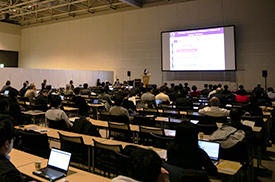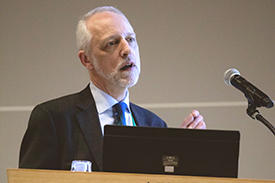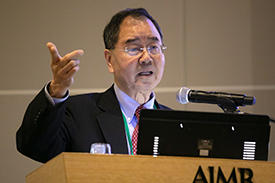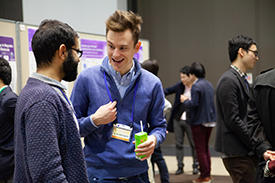

03/25/2019

Tohoku University’s selection as a Designated National University by the Japanese government in 2017 is spurring efforts to build up world-class research capabilities in four of its strongest fields: materials science, spintronics, next-generation medical care, and disaster science. As a continuation of the inaugural 2018 symposium that celebrated new beginnings in two of these fields, materials science and spintronics, the Second Symposium for World Leading Research Centers was held in Sendai on 16–18 February 2019.
The meeting gave more than 250 researchers from Japan and around the world a valuable opportunity to exchange ideas about topics as wide ranging as structural materials, electronic materials, biomaterials, energy materials, mathematics and informatics. A recurring theme of the symposium was the importance of collaboration that transcends disciplinary and national borders.
In his opening remarks, Hideo Ohno, a renowned physicist and the president of Tohoku University, noted that many of history’s greatest scientific achievements were realized through collaboration. By way of example, he described Tohoku University’s outstanding contributions in the field of magnetism, from the pioneering work of Kotaro Honda more than a century ago to Masato Sagawa’s recent invention of the strongest magnets. Ohno expressed his hope that collaborative efforts between disciplines will continue to build on such successes.
Motoko Kotani, director of the AIMR, shared further examples of the university’s breakthroughs in materials research, computer science and engineering. She explained how Tohoku University is adopting a multilayer approach to establish an ecosystem designed to strengthen research activities not only at the new materials science center but also across the university’s core research clusters.
“More than 400 researchers are now working on materials science at Tohoku University,” she said. “And synergy is the key to building successful interdisciplinary research alliances with a global reach.”
As the leader of the spintronics research center, Yoshiro Hirayama, professor at Tohoku University’s Department of Physics, explained how activities at the Center for Science and Innovation in Spintronics and its core research cluster are “laying technological foundations for next-generation Internet of Things (IoT) applications.” He also spoke of the key partnership between Tohoku University and Tsinghua University as a springboard for more developments in spintronics and topological materials.
Qi-Kun Xue, a professor and vice-president of Tsinghua University in Beijing, China, and a principal investigator at the AIMR, stressed the importance of materials science and spintronics research for realizing sustainable development. The close collaborations between Tsinghua University and Tohoku University nurtured over more than 20 years, he said, will continue to encourage joint research in these critical fields.

The first of two plenary speakers was Alan Lindsay Greer, a professor of materials science at the University of Cambridge and a long-time collaborator and principal investigator at the AIMR. He outlined developments in crystallization studies on different kinds of glass-forming systems such as polymers, chalcogenides, metals and alloys. Greer described a remarkable range of crystal growth rates correlated with thermodynamic and kinetic parameters — of fundamental interest as well as of potential importance for developing ultrafast computing systems. “Studies of fast crystallization are relevant for computer memory, and may point to the application of metals for fast phase change,” he said.
Greer then reflected on the question of whether pure metals could be considered glass formers, despite previous assumptions to the contrary. “It seems we can, and this may even be exploitable,” he said, describing the concept of liquid fragility, and how a possible crossover from fragile to strong liquid behavior on cooling could be a vital part of understanding fast crystal growth. “The ancients knew about this property of glasses, as it turns out to be highly relevant to glass blowing,” Greer noted. “And this fragile-to-strong crossover may be important for the performance of memory devices.”
Sharing images of nineteenth-century glazed pottery from France and Japan, Greer gave other examples of what can be achieved by phase transformation. The ring patterns in these artworks, he explained, indicate where the potter has changed the temperature of the furnace, and are subject to a considerable degree of control. Greer drew parallels between these patterns and the nanoscale spiral patterns produced by an intriguing phenomenon known as explosive crystallization in amorphous thin films. Much still remains to be explored, Greer suggested, in designing and optimizing materials for phase-change applications.

In a talk titled ‘Why should we care about topological quantum computer?’, Kang Wang of the University of California, Los Angeles, spoke about the exciting possibilities that would be opened up by quantum computing devices to solve problems that go far beyond the limits of classical computers. There is great potential in drug discovery, techniques for analyzing the whole body, smart traffic management, earthquake disaster prevention, and even the ability to count the number of atoms in the observable universe.
Today’s computers are based on a binary system that uses zeros and ones and operates in a sequential mode. In contrast, quantum computers “offer a drastically different way of computing in massive parallelism using quantum bits (qubits), which are superimposed or entangled, such that one and zero can no longer be considered independent states,” Wang explained. “However, the superposition and entanglement need to maintain phase coherence, which is the key challenge for realizing quantum computing and scaling up the number of qubits.”
Wang described how his group has discovered a new direction for realizing robust topological quantum computing that overcomes the challenge of decoherence. They have found firm evidence for the existence of the elusive Majorana fermion — a particle that is its own antiparticle, which was theoretically predicted by Ettore Majorana in 1937. “Majorana particles could be used as topological qubits to realize robust topological quantum computing,” Wang said.
The symposium’s seven sessions included two additions this year: a session on mathematics and informatics chaired by Hiroshi Suito, a principal investigator at the AIMR, and another on Tohoku University’s new Graduate Program in Materials Science (GP-MS), led by Katsunari Oikawa, a professor at the Graduate School of Engineering. GP-MS officially launches in April 2019, and it joins a growing list of international double-degree programs that includes the Graduate Program in Spintronics (GP-Spin) and the Graduate Program in Data Science (GP-DS).
The addition of this mathematics and informatics session reflects the growing role that mathematics and its applications play in a data-rich world. “At the AIMR, one of our unique strengths is our ability to investigate materials science underpinned by mathematics,” said Kotani. “And in today’s digitalized society, we are seeing the rise of artificial intelligence, IoT and big data. More and more researchers, not just at the AIMR but around the world, are interested in extending mathematical ideas to these areas. The new session is a good opportunity to showcase what we can do.”
Mathematics is a universal language that cuts across traditional disciplines, Kotani said. Commenting on AIMR’s allure for the world’s top minds, she expressed her hope that more women will be inspired to consider research paths and careers in mathematics and materials sciences.

The three-day symposium, which covered a wide range of fields, was highly successful in promoting multidisciplinary research and international collaboration, thanks to the attendance of collaborators and friends from around the world. It provided a forum for lively discussions about the cutting edge of materials science and spintronics — two fields which the AIMR has been focusing on since its foundation.
A more specialist workshop on glasses had been held as a satellite event a day prior to the symposium. First held in 2012 to promote collaboration between the fields of mathematics and materials science, this workshop has been held every year subsequently. It gave participants more opportunities for in-depth discussions about metallic glasses and other amorphous materials.